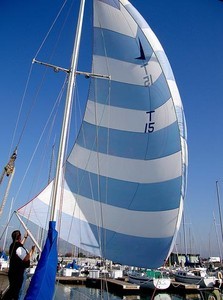How to sail into a slip without holing the hull
by Edward Killeen, www.examiner.com on 14 Apr 2009

Sailing into a slip - a jittery process for the unpractised SW
For centuries, sailors relied on sails alone. Captains would have to sail into a harbor, find where to drop anchor and sail out when the time came. Sure they had oars and beefy guys in rowboats to guide them into the docks. But they didn't have a trusty Yanmar diesel inboard to fall back on.
If you spend some time around a marina nowadays, you'll see boats dropping their sails outside or inside the marina but rarely at the dock. Sailors turn into powerboaters when it comes to reaching land.
But what happens if your trusty iron-genoa fails? Do you call SeaTow or, worse yet, the Coast Guard? Heck no, you need to sail into your slip. You have to practice though. If you've ever done it or seen someone glide gracefully into their slip under sail, you know it doesn't just happen by accident. Keel boats generally have a couple hundred to several thousand pounds of lead attached to the bottom...you need to be able to stop all the momentum that the keel creates.
It is easiest if you have an upwind slip. To sail into that, you depower the boat (think boomvang, traveller, luffing sails) as you approach, then turn the boat into the wind and let that magical keel momentum bring you in. Having a spring line handy helps slow you down too. I generally go in under main only but I've seen others go in jib-only and both sails. I just hate that jib luffing while I'm trying to get onto the dock. Always be sure to have fenders out.
Sailing into a slip with the wind on your beam is more difficult. In my experience, you need to drop sails as you're turning into your slip, let the momentum carry you forward into the slip and the windage push you into the finger itself. Remember, lots of fenders!
Downwind is also tricky. It's hard to depower the boat but you also have the advantage of windage pushing you where you want to go. I generally get the boat pointed into the slip, drop the sail(s) quickly, and have spring lines ready to stop the boat. You have to stop the boat with dock lines in this situations or you're looking at your bow and the dock doing it for you.
The key is to practice on progressively windier days. Try it on a light wind day and work yourself up to when it's breezier. Engines only fail when there's no wind or too much wind. It's the Rule of the Ocean. It's essential you've practiced on all types of days. Try to have a bailout plan, know where the point of no return is and bail before then if you're not going to make it. Then Sail back around and try again.
Back to the emergency situation. Now that you've practiced a few times, you can feel comfortable sailing into a slip in most wind conditions. That being said, my emergency plan doesn't always take me to *my* slip. I have open spots picked out in the marina for most wind directions, places where I can just get back to land safely under sail (fuel dock, yacht club guest dock, unused side ties, etc.). Once I'm tied safely to someplace solid, I can figure out how to get back to my own slip. The key is get to land. And to look cool doing it.
Key considerations: Always have docklines and fenders ready and deployed. Practice with your engine on idle until you get the feel for it. Practice when there are people on the dock watching, this will always be the case when it's an emergency situation; they will invariably watch and chuckle and not realize they should be giving you a hand until it's too late. Disclaimer: there are a million ways to do it, the above examples are what works for me and my particular slip.
Edward is a Sailing www.examiner.com!Examiner and a lifelong sailor with two ocean crossings and a ton of daysails to his credit. Living on San Francisco Bay allows him to sail year round and he tries to take advantage of that.
If you want to link to this article then please use this URL: www.sailworldcruising.com/55800